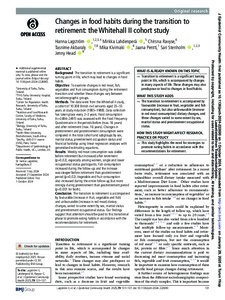Changes in food habits during the transition to retirement: the Whitehall II cohort study
Lagström, Hanna; Lahdenperä, Mirkka; Ravyse, Chirsna; Akbaraly, Tasnime; Kivimäki, Mika; Pentti, Jaana; Stenholm, Sari; Head, Jenny
https://urn.fi/URN:NBN:fi-fe2025082787724
Tiivistelmä
Background The transition to retirement is a significant turning point in life, which may lead to changes in food habits.
Objective To examine changes in red meat, fish, vegetables and fruit consumption during the retirement transition and whether these changes vary between sociodemographic groups.
Methods The data were from the Whitehall II study, a cohort of 10 308 British civil servants aged 35-55 years at study induction (1985-1988). Data collection has taken place every 2-3 years. Food consumption (n=2484-2491) was assessed with the Food Frequency Questionnaire in the periods before (max. 16 years) and after retirement (max. 16 years). Changes in preretirement and postretirement consumption were compared in the total cohort and subgroups by sex, marital status, preretirement occupation status and financial hardship using linear regression analyses with generalised estimating equations.
Results Weekly red meat consumption was stable before retirement but increased after retirement (p=0.02), especially among women, single and lower occupational status participants. Fish consumption increased during the follow-up and the increase was steeper before retirement than postretirement period (p=0.02). Vegetable and fruit consumption also increased during the entire follow-up, but more strongly during preretirement than postretirement period (p<0.001 for both).
Conclusion The transition to retirement is accompanied by favourable (increase in fruit, vegetable and fish) and unfavourable (increase in red meat) dietary changes, varied to some extent by sex, marital status and preretirement occupational status. Our findings suggest that attention should be paid to this transitional phase to promote eating habits in accordance with the recommendations for retirement.
Kokoelmat
- Rinnakkaistallenteet [27094]
